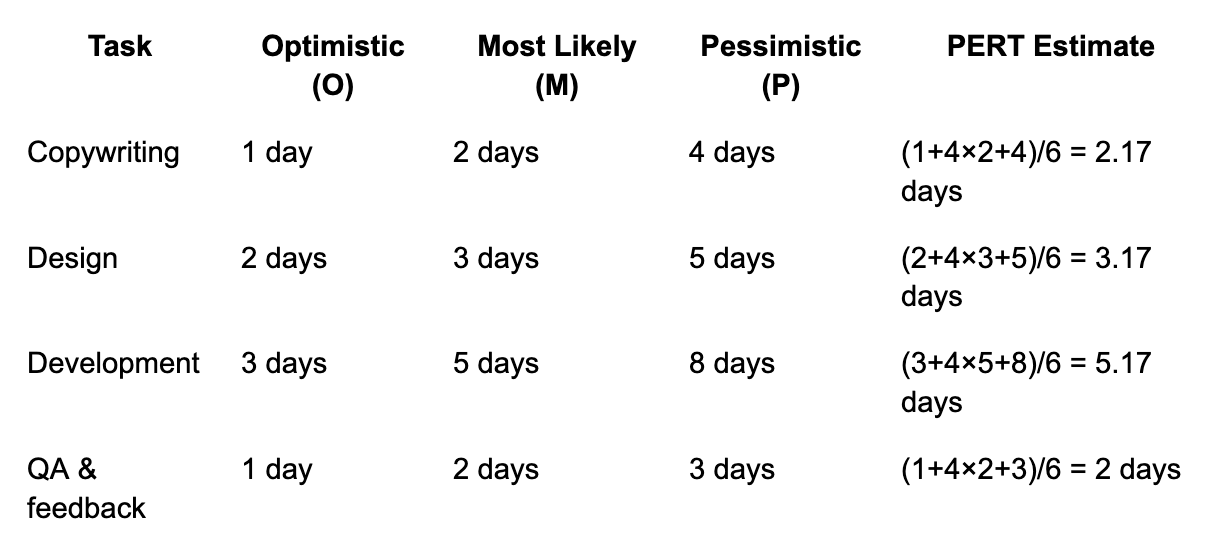3-Point Estimation: How To Create Safer Project Budgets Without Losing Your Mind
A simple process to add to your tool kit.
Estimating is hard.
Not only is it hard for project managers, it’s even harder for your team.
Like when you rock up and ask your copywriter how long it will take to write a landing page, or your software engineer to build a chatbot.
Cue: blank, nervous faces, complete with shrugs 🤷
On the other side of the fence, you have your account team or your clients wondering why their project went over budget, even though they are on their 10th round of content amends.
Your PM Holy Trinity
To quickly, recap basics for those of you who are new to project management.
At the start of any project, you need 3 key things to get going:
A Scope of Work
An estimate
A project plan (timeline)
They are inseparable, and you can’t kick things off without them. Not forgetting a purchase order so you can bill the work!
And you need to make sure your estimate is accurate, whilst controlling the scope and aligning to a timeline that meets your clients (and Agency’s) needs.
There are many ways to estimate projects, and the 3 point estimation technique is becoming my go-to method.
Caveat - I do combine it with a careful analysis of previous, similar projects with the same client. Otherwise, known as analogous estimation. That way I can make sure I’m in the right ballpark.
What Is 3-Point Estimation?
3-Point Estimation is time-based.
The idea is, you’re trying to predict how long a task will take — by discussing with your team:
Optimistic Time (Best Case)
Most Likely Time (Normal Case)
Pessimistic Time (Worst Case)
You then average or weigh those numbers to come up with a realistic time estimate (e.g., “this task should take 6.5 days”).
Why Should You Care About 3-Point Estimation?
It helps reach consensus with your team on the time it takes to complete a task.
Not everyone has the same experience. You might have a junior writer available who cannot write the content as quickly as someone senior.
With your client - you’ll provide constraints and reasons around why numbers are the way they are. For example, if you have 1 round of amends, then I can give you an Optimistic time. But if you want 5 then you’re looking at worst case numbers.
You can turn the 3 options into different timelines for delivery. Clients love choice.
Overall, it’s giving you a nice safety net to fall back on by reducing the risk of budget overruns.
How You Can Use 3-Point Estimation (Step-by-Step)
Step 1: Get Your Three Numbers
Talk to your team. Look at past projects. Then list:
Your Optimistic number (O)
Your Most Likely number (M)
Your Pessimistic number (P)
Step 2: Do Some Maths
There are two ways to crunch the numbers and to be honest, I’m a bit crap at maths, so I use the first option, or cheat by creating a spreadsheet.
Option 1: Triangular Formula
(O + M + P) / 3
Example:
If O = 4 days, M = 6 days, and P = 11 days...
(4 + 6 + 11) / 3 = 7 days
Option 2: PERT Formula (more accurate)
(O + 4M + P) / 6
Using the same numbers:
(4 + 4*6 + 11) / 6 = 6.5 days
Step 3: Share It Clearly
When you tell your client or team, show them:
Optimistic: 4 days
Most Likely: 6 days
Pessimistic: 11 days
Final Estimate (PERT): 6.5 days
Here’s an example
You ask your team to give Optimistic (O), Most Likely (M), and Pessimistic (P) time estimates for each task:
Add it up:
2.17 + 3.17 + 5.17 + 2 = 12.5 working days
👉 You tell the client:
"This project will take about 2.5 weeks from the kick-off date, factoring in review rounds and sign off."
That’s it
Pick a small project to build your confidence.
Ask your team. Get input from the people doing the work.
Stay honest. Use it as a way of growing your relationship with your colleagues and your clients by having practical conversations.
Check old project budgets and timelines. Make sure you’re in the right ballpark.
Reconcile your numbers at the end and see how you get on.
Chat soon,
–Tim
Founder of The Wash-Up


